On April 20, the 2023 China Optics Top Ten Progress Summit Forum opened in Fuyang District of Hangzhou, Zhejiang Province, and China Laser Magazine released the 2022 China Optics Top Ten Progress and held an award ceremony. The achievements of Professor Li Zhiyuan's team from the School of Physics and Optoelectronics of South China University of Technology won the nomination award of Top Ten Progress in China Optics 2022 (Basic research category).
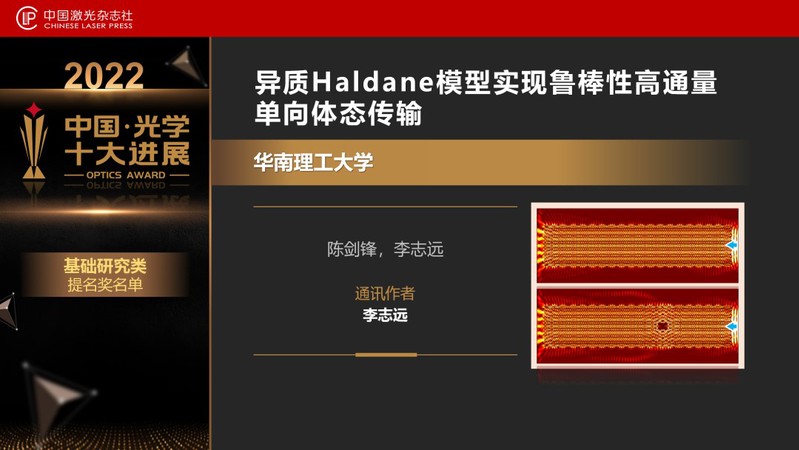
01 Guide
Professor Zhiyuan Li and his team at the South China University of Technology proposed a heterogeneous Haldane model to predict the existence of unidirectional states in electronic systems, which can achieve high throughput energy transport. They further extended the model to the field of photonics, and realized long distance, large area, high flux, and strong robust unidirectional state transmission of electromagnetic waves in heteromagnetized compact two-dimensional honeycomb magneto-optical photonic crystals. This work expands people's understanding of topological phases, enricheds the means of topological state regulation, and provides new ideas for developing high-throughput and robust performance-energy transport materials and structures. The relevant results are based on Prediction and observation of robust one-way bulk states in a gyromagnetic photonic area. crystal was published in Physical Review Letters on June 21, 2022.
02 Research Background
Among the many characteristics and phenomena of topological physical systems, strong robust unidirectional transmission immune to defects, disorder and obstacles is undoubtedly the most eye-catching, and this unidirectional transmission was first proposed in electronic systems. It can be described by the classical Haldane model with time-inversion symmetry breaking [Phys. Rev. Lett. 61, 2015-2018 (1988)].
The classical Haldane model is characterized by chiral one-way boundary states, that is, one-way boundary states on two parallel boundaries of the bulk material/structure that travel in opposite directions. In 2018, E. Colomes and his collaborators proposed an improved Haldane model [Phys. Rev. Lett. 120, 086603 (2018)], predicting the existence of a backhanded unidirectional boundary state, that is, a unidirectional boundary state on two parallel boundaries of a bulk material/structure that is transmitted in the same direction.
It can be said that the chiral/antichiral one-way boundary state generated by the classical Haldane model and the improved Haldane model is still the most reliable scheme to achieve strong robust one-way transmission. However, due to the inherent boundary state properties, the energy collection and transport can only be localized at the boundary of two-dimensional bulk materials/structures, which limits the high-throughput energy transport to a low level, and also greatly sacrifices the space utilization of bulk materials/structures.
It can be seen that the realization of unidirectional state transport in two-dimensional bulk materials/structures can not only expand people's knowledge of topological physics, but also have important significance for the design and implementation of large-area, high-throughput and strong robust energy transport materials/structures.
03 Research innovation points
Research innovation point 1: A heterogeneous Haldane model is proposed to predict the existence of unidirectional states in electronic systems
By comparing classical, improved and heterogeneous Haldane models, the team found that the heterogeneous Haldane model not only inherits the topological properties of the first two models, but also produces one-way states that can be independently excited. In the classical Haldane model, the two sets of sublattices have unequal subneighbor transitions (vij=±1), and the degeneracy of the Dirac points is broken, resulting in a complete band gap supporting a chiral unidirectional boundary state, as shown in Figure 1 (A-C). In the modified Haldane model, the two sets of sublattices have equal subneighbor transitions (vij=+1 or vij=-1), and the degeneracy of the Dirac points is not broken, but the energy bands are inclined, resulting in a reverse chiral one-way boundary state and a one-way state associated with the boundary state that is propagated in the opposite direction, as shown in Figure 1 (d-f).
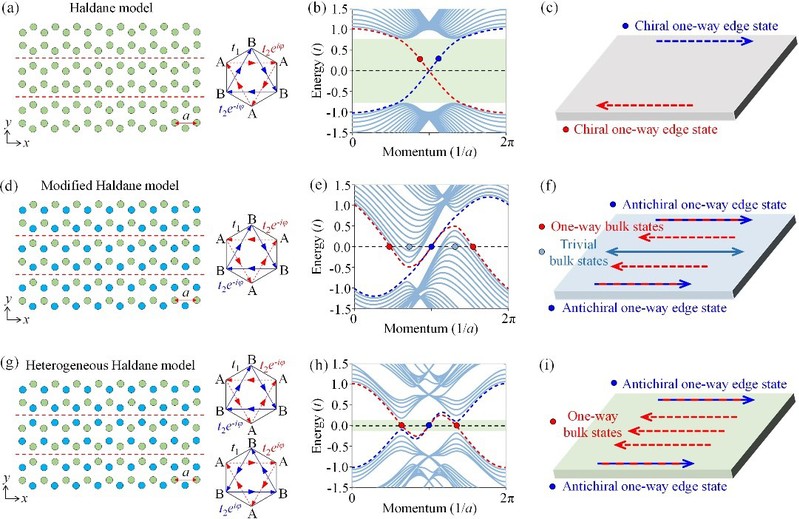
FIG. 1 Schematic diagram of structure, projected energy band and topological state of three Haldane models
Because the boundary state and its associated states are relatively separated in space, the electrons can be transmitted almost perfectly along the boundary in one direction. In bulk materials, due to the existence of bidirectional mediocrity, backscattering cannot be avoided when transporting electrons in bulk materials. To solve this problem, the researchers further implemented the heterogeneous Haldane model by alternately stacking improved Haldane models with opposite subneighbor transitions to separate the mediocre bidirectional state so that one-way transport of electrons can occur not only at the boundary, but also in the bulk material, as shown in Figure 1 (g-i).
Research innovation point 2: Expand to the field of photons to achieve long-distance, high-throughput, strong robust one-way transmission
The team further extended the heterohaldane model to the field of photons, suggesting that the unidirectional photon state can be realized in heteromagnetized two-dimensional honeycomb magneto-optical photonic crystals. Different from the traditional magneto-optical photonic crystal experiment in which a large magnet device is used to implement uniform magnetization as a whole, they use pairs of NdFeb small magnets to apply individual magnetization to each magneto-optical medium column, and the magnetization direction can be changed by turning the N/S pole of the magnet [Phys. Rev. B 101, 214102 (2020)].
This magnetization scheme can not only provide the required magnetization requirements to meet the heterogeneous Haldane model, but also can free people from the dependence on large magnetic field equipment, reduce the threshold of magneto-optical photonic crystal experiments, but also make the overall structure more compact, more flexible magnetization scheme, and more convenient experimental measurement.
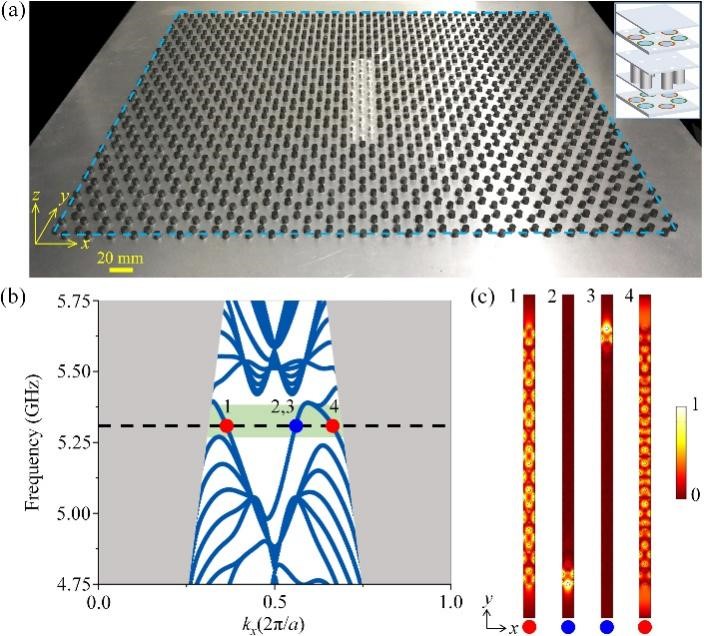
FIG. 2 Heterogeneous magnetized two-dimensional magnetic photonic crystal experimental sample, projected energy band and intrinsic field distribution
The team carried out microwave experiments in heteromagnetized two-dimensional magneto-optical photonic crystals, measured the electric field distribution and transmission spectrum, observed the existence of unidirectional state and verified its transmission robustness.
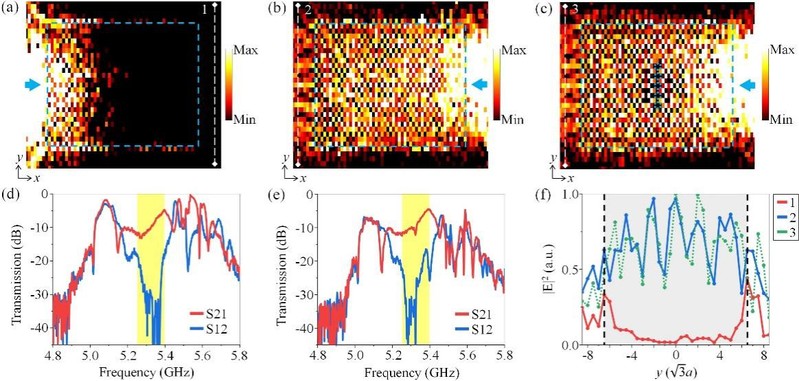
FIG. 3 Field distribution, transmission spectrum and electric field intensity in heterogeneous magnetized two-dimensional magneto-optical photonic crystals
The researchers further constructed a long magneto-optical photonic crystal with a length of 100 lattice constants in an open space, showing that even without an external metal covering, the right-end incident electromagnetic wave can still be localized almost perfectly in the magneto-optical photonic crystal under barrier-free, weak barrier and strong barrier conditions. It realizes the long distance, large cross-sectional area, high energy flux and strong robust unidirectional state transmission of electromagnetic wave.
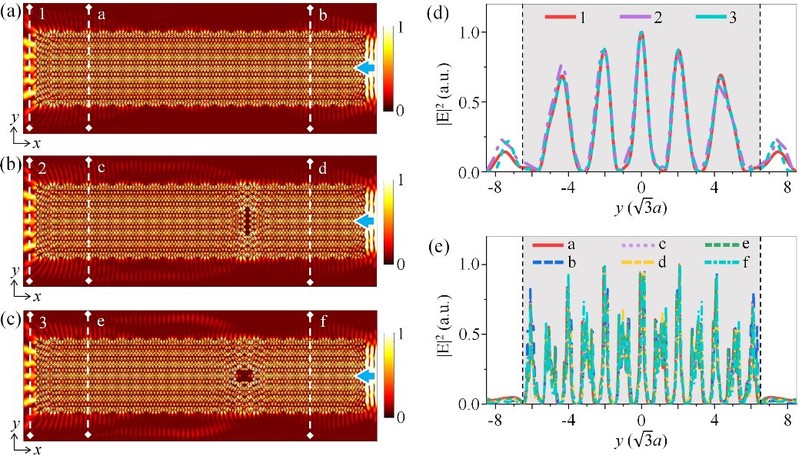
FIG. 4 Long distance, large area, high throughput, strong robust unidirectional state transmission
04 Summary and prospect
This work expands people's understanding of topological phases, enricheds the means of topological state regulation, and provides new ideas for developing high-throughput and robust performance-energy transport materials and structures. If this model can be implemented in some electronic material systems, then using powerful topological physics principles, resistance-free and backscattering free conductive transmission lines with large current capacities may become a reality. This will be the second technical scheme to achieve current transmission without resistance based on topological physics principles after superconductivity, which has potential significant scientific, technical and socio-economic value.
The corresponding author is Li Zhiyuan, professor of the School of Physics and Optoelectronics, South China University of Technology, and the first author is Chen Jianfeng, PhD candidate in 2019. The research work has been funded by the introduction of innovation and Entrepreneurship team project of Guangdong Province, the project of the National Fund Commission, and the key research and development project of the Ministry of Science and Technology.



